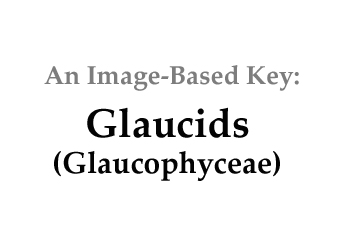|
|
||||
|
Click on images for larger format |
||||
|
Name origin: L. glaucus, Greek γλαυκός - glaukós, blue-green, blue-grey). The Glaucophyceae, or Glaucocystophyta, described by Kies and Bremer (1990), are considered to be an artificial grouping (John et al. 2002) although rRNA sequences are similar among the three genera Cyanophora, Glaucocystis, and Gloeochaete (Helmchen et al. 1995). Also mtDNA (mitochondrial DNA) evidence suggests monophyly of the glaucophyceae, including the above well-recognized genera and a fourth, Cyanoptyche gloeocystis (Jackson and Reyes-Prieto 2014). However, analyses of plastid and mitochondrial tenes suggest sugstantial divergence between some strains of Cyanophora paradoxa and Glaucocystis nostochinearum. Some authors consider them to be part way along an evolutionary trail from cyanobacteria to chlorophytes and/or rhodophytes (Whitton 2011). Early divergence of glaucophytes from reds and greens (including higher plants) is supported by phylogeny based on proteins that are nuclear encoded and plastid targeted (Reyes-Prieto and Bhattacharya 2007). The authors note that several ancestral features have been lost in reds and greens, supporting the idea that the glaucophytes diverged early in the evolution of the three lines of archaeoplastids. The cyanelle peptidoglycan layer (CPL) surrounding the cyanelles, the carboxysomes, and an ancestral form of fructose-1,6-bisphosphate aldolase (FBA II) are all absent from reds and greens. Phycobilins and nonstacked thylakoid membranes similar to those in the cyanobacteria are also lost from reds and greens. Glaucids, bright blue-green in color, are described as colorless (chlorophycean?) eucaryotic hosts containing from two to several pigmented cyanoplastids called cyanelles. Only Glaucocystis has a cellulose outer wall. The cyanelles have an outer membrane more similar to cyanobacteria than to chloroplast outer membranes. Photopigments include Chl a, phycobilisomes (phycoerithin, phycocyanin, and allophycocyanin), and beta-carotene in common with the cyanobacteria. Starch granules develop in the host cytoplasm, but not within the cyanelles. All higher plant plastids (chloroplasts) arose from a proposed single ‘primary’ endosymbiotic event approximately 1.5 bya, including a critical step – the transfer of endosymbiont genes to the ‘host’ nucleus (Bhattacharya and Boore 2009, Price et al. 2012). Subsequently that ‘common ancestor’ formed from a cyanobacterial unicell embedded within a phagocytic eukaryotic cell evolved along three archaeoplastid lines – Glaucophyceae, Rhodophyceae, and Chlorophyceae. The first two share phycobilins and chlorophyll a, while the last has lost the phycobilins and added chlorophyll b.
|
||||
|
References: |
||||
|
Bhattacharya, D. and J.L. Boore 2009. The complete genome sequence of the glaucophyte alga Cyanophora paradoxa. Poster, ‘Annotation Jamboree’, Rutgers University, Fall 2009 (online). Helmchen, T.A., D. Battacharya and M. Melkonian 1995. Analyses of ribosomal RNA sequences from glaucocystophyte organelles provide new insights into the evolutionary relationship of cyanelles. Journal of Molecular Evolution 41:203-210. Jackson, C.J. and A. Reyes-Prieto 2014. The mitochondrial genomes of the Glaucophytes Gloeochaete wittrockiana and Cyanoptyche gloeocystis: Multilocus phylogenetics suggests a monophyletic Archaeplastida. Genome Biological Evolution 6(10):2774-2785. John, D.M., B.A. Whitton, and A.J. Brook 2002. The Freshwater Algal Flora of the British Isles. Cambridge Press. (702 pp.) Kies, L., and B.P. Bremer. 1986. Typification of the Glaucocystophyta. Taxon 35(1):128-133. [online] Kies, L., and B.P. Bremer. 1990. Phylum Glaucocystophyta. In: Margulis, J.O., M. Corliss, M. Melkonian, and D.J. Chapman, eds. Handbook of Protoctista. Jones & Bartlett, Boston. pp 152-166. Price, E.C. et al. 2012. Cyanophora paradoxa genome elucidates origin of photosynthesis in algae and plants. Science 335:843-847. Reyes-Prieto, A.R. and D. Bhattacharya 2007. Phylogeny of nuclear-encoded plastid-targeted proteins supports an early divergence of glaucophytes within plantae. Molecular Biological Evolution 24(11):2358-2361. Whitton, B.A. 2011. Glaucophyta. In: John, D.M., B.A. Whitton and A.J. Brook, Eds. The freshwater algal flora of the British Isles 878 pp). |
||||




